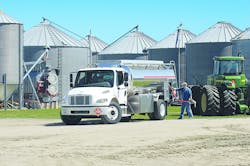As business conditions have become more demanding, many fleets have kept vehicles and equipment in service for longer periods of time. Useful service life has lengthened thanks to enhanced vehicle engineering, technological advancements and improvements in vehicle quality and reliability.
However, as a fleet ages, vehicles cost more to operate, as there is more vehicle downtime due to unplanned maintenance and repairs. There are also lost opportunities to leverage advances in vehicle technology, especially in relation to fuel efficiency.
The challenge for fleets is to decide when to keep repairing vehicles – and how much work should be done on them – or would it make more financial sense to replace them.
METHODS
In general, fleets employ several main methods to determine when to replace a vehicle:
- Take a wait-and-see strategy, wherein vehicles are replaced only when necessary or when there are safety concerns.
- Use a replacement interval that is based on established age and mileage for the vehicle type and its application.
While this is a straightforward method, it does not take into consideration the fact some vehicle brands and models are more reliable than others. Consequently, this can result in some less reliable vehicles being kept in service longer, incurring additional maintenance and repair costs.
Conversely, other more durable vehicles may be taken out of service although they may have more reliable service life left in them.
- Make the decision to replace a vehicle when the cost to repair exceeds the value of the vehicle. This usually involves a major component like an engine or a transmission.
The objective is to sell a vehicle prior to a major breakdown. The problem is determining when that might occur.
- Use a lifecycle cost analysis. This is a process to predict the optimum economic life of a vehicle, taking into account both fixed and operating costs over its entire useful term, based upon mileage or age of vehicle.
Fixed costs are those related to purchasing and owning, including initial purchase price, age, depreciation and insurance. Operating costs are those associated with ongoing operation of the vehicle, including vehicle productivity, driver/operating training and pay, maintenance, tires, fuel and other consumables, repairs, mileage, staff costs and overhead and disposal – trade-in, resale or salvage value.
ADDED EXPENSES
“As a vehicle’s lifecycle is extended, maintenance costs begin to quickly accelerate in two ways,” explain officials at Donlen Corporation (http://www.donlen.com), a provider of financing and fleet management solutions for corporate fleets.
“First, through typical preventive vehicle maintenance expenses which occur throughout the fleet’s lifecycle. Second, and perhaps more alarming, is the explosion of unplanned other maintenance, such as drivetrains, suspensions, engines and numerous other components that can generate larger out-of-pocket cost and disruptive vehicle downtime.”
When these costs exceed the vehicle’s fair market value, the officials continue, “the result is an inefficient vehicle trapped in an undesired extended lifecycle that quickly begins to compound the fleet’s overall costs.”
The officials note that unplanned maintenance – and thus additional downtime – also costs in terms of lost time and revenue, decreased driver productivity, road service calls, towing expenses for broken down vehicles, vehicle rental costs and operational inefficiency. What’s more, an aging fleet is not taking advantage of changes in vehicle technology, components and designs that can improve fuel economy, lower emissions, increased safety, reduced maintenance requirements and longer warranties.
ADDITIONAL USES
Lifecycle cost analysis also can be used to:
- Establish guidelines by age and mileage for the vehicle type and its application before vehicles are placed into service.
- Assess in-service vehicles to determine whether they should continue in service or be replaced.
- Judge the economics of “rebuilding” a vehicle to extend its service life versus replacing it with a new vehicle.
- Compare brands and models when purchasing a new vehicle.
- Determine whether alternative-fuel vehicles are an economically viable option in comparison to traditional gasoline- or diesel-powered vehicles.
A best practice is to perform lifecycle cost analysis on a regular basis because vehicles, components, technology and market and business conditions are continually changing. Managing vehicle efficiency is a never-ending challenge and regular cost analysis will monitor vehicles and show when a vehicle is no longer profitable and is actually costing money to operate.
Being armed with such information enables management to prepare for a smooth transition to repair the vehicle, remove it from the fleet or acquire a new vehicle, without negatively impacting a company’s operation. Consideration of the costs over an asset’s lifecycle provides a sound basis for decision making.
About the Author

